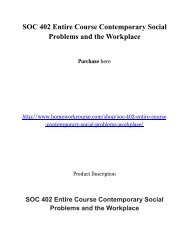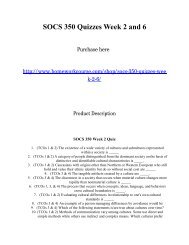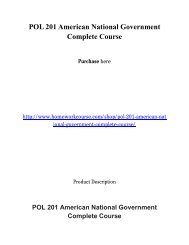SOC 305 Crime and Society Course Material Week 1 to 5 Ashford
You also want an ePaper? Increase the reach of your titles
YUMPU automatically turns print PDFs into web optimized ePapers that Google loves.
<strong>SOC</strong> <strong>305</strong> <strong>Crime</strong> <strong>and</strong> <strong>Society</strong> <strong>Course</strong> <strong>Material</strong><br />
<strong>Week</strong> 1 <strong>to</strong> 5 <strong>Ashford</strong><br />
Purchase here<br />
http://www.homeworkcourse.com/shop/soc-<strong>305</strong>-crimesociety-course-material-week-1-5-ashford/<br />
Product Description<br />
<strong>SOC</strong> <strong>305</strong> <strong>Crime</strong> <strong>and</strong> <strong>Society</strong> <strong>Course</strong> <strong>Material</strong> <strong>Week</strong> 1 <strong>to</strong> 5 <strong>Ashford</strong><br />
<strong>SOC</strong> <strong>305</strong> (<strong>Crime</strong> & <strong>Society</strong>)<br />
<strong>Week</strong> 1<br />
<strong>Week</strong> 1 DQ 1 Moral Panic<br />
After viewing the video, Gender & <strong>Crime</strong>, please address each of the<br />
following questions:<br />
1. Is crime normal in a society?<br />
2. What is the purpose of crime <strong>and</strong> punishment?
3. How much crime is “enough,” <strong>and</strong> how would this be measured?<br />
4. How is crime defined?<br />
5. What problems are defined as worthy of social control?<br />
6. What is the influence of the media?<br />
<strong>Week</strong> 1 DQ 2 Race <strong>and</strong> Death Row<br />
This discussion focuses on <strong>to</strong>pics addressed in several chapters of your<br />
text – the death penalty <strong>and</strong> discrimination. Although first discussed<br />
in Chapter 2, the death penalty is also discussed in Chapter 4. Rather<br />
than thinking in rigid terms about reading assignments, please use<br />
your textbook as a resource. After reading the text <strong>and</strong> watching the<br />
video, Injustice for Blacks in Alabama, respond <strong>to</strong> each of the<br />
following questions:<br />
Your initial post should be at least 250 words in length. Support your<br />
claims with examples from the required material(s) <strong>and</strong>/or other<br />
scholarly resources, <strong>and</strong> properly cite any references. Respond <strong>to</strong> at<br />
least two of your classmates’ posts by Day 7.<br />
1. What do you think best explains high incarceration rates for<br />
Blacks compared <strong>to</strong> their percent of the general population?<br />
2. What do you think explains high incarceration rates for Blacks on<br />
death row?<br />
3. Is institutionalized racism <strong>to</strong> blame for these disparate rates?<br />
Please explain.
4. Are genuinely high rates of Black crime <strong>to</strong> blame? Why or why<br />
not?<br />
5. What other fac<strong>to</strong>rs explain the high incarceration rates for Black<br />
men?<br />
6. How can this problem be solved?<br />
<strong>Week</strong> 1 Assignment:<br />
<strong>Week</strong> 1 Quiz 10 MCQ’s<br />
<strong>Week</strong> 2<br />
<strong>Week</strong> 2 DQ 1 Legal Representation <strong>and</strong> Social Class<br />
After listening <strong>to</strong> the interview with Stephen B. Bright, The quality of<br />
a legal defense: Does it matter if you’re rich or poor?, please respond<br />
<strong>to</strong> the following:<br />
1. How does geographic location play a role in the quality of<br />
representation provided by the public defender?<br />
2. How does the overburdened public defense system in many<br />
areas contribute <strong>to</strong> issues of wrongful conviction?<br />
3. Contrast the legal representation described by Bright <strong>to</strong> the level<br />
of representation available <strong>to</strong> white-collar, corporate, <strong>and</strong><br />
environmental crimes.<br />
4. This discussion highlights two issues – wrongful conviction <strong>and</strong><br />
the overburdened public defender system. How can these<br />
problems be solved?
<strong>Week</strong> 2 DQ 2 The War on Drugs<br />
After reading this week’s required text, please respond <strong>to</strong> the<br />
following:<br />
1. In your opinion, what have been among the main outcomes of<br />
the War on Drugs?<br />
2. How close has it come <strong>to</strong> its original goals of reducing drug use<br />
<strong>and</strong> punishing drug suppliers?<br />
3. How has this “war” impacted African-American males?<br />
4. How has this “war” impacted immigration policy?<br />
5. How will this “war” end?<br />
<strong>Week</strong> 2 Assignments:<br />
Final Paper Preprations Overcrowding in Correctional<br />
institutions (1350+ Words)<br />
<strong>Week</strong> 2 Quiz 10 MCQ’s<br />
<strong>Week</strong> 3<br />
<strong>Week</strong> 3 DQ 1 Child or Adult?<br />
Determining whether <strong>to</strong> try a child in the juvenile or the criminal justice system w<br />
have an impact on every step of his or her experience. Although the exact laws an<br />
practices of the systems vary from state <strong>to</strong> state, broad underlying beliefs<br />
differentiate the two systems. While the juvenile system is often thought <strong>to</strong> be<br />
more lenient in its punishments, there are often stricter regulations throughout t
process. In the juvenile system a child may not have a right <strong>to</strong> a jury trial or bail<br />
Juvenile records are not open <strong>to</strong> public access like criminal records <strong>and</strong> parole is<br />
very different between the two systems. When the child in question is considered<br />
child, the courts act as more of a parent attempting <strong>to</strong> punish but also protect.<br />
<strong>Week</strong> 3 DQ 2 Relationships in Prison<br />
Women’s relationships in prison commonly fulfill an emotional need.<br />
They are different from men’s sexual relationships in prison in that<br />
they are less likely <strong>to</strong> involve coercion or be motivated by power <strong>and</strong><br />
status grabs. In addition <strong>to</strong> romantic relationships, female inmates are<br />
also likely <strong>to</strong> form prison families with roles that mimic mothers,<br />
sisters, <strong>and</strong> even gr<strong>and</strong>mothers. For many inmates, their prison family<br />
is the first positive female role modeling they have encountered.<br />
<strong>Ashford</strong> <strong>SOC</strong> <strong>305</strong> <strong>Week</strong> 3 (Myths <strong>and</strong> Reality of <strong>Crime</strong>). 900+ Words<br />
<strong>Week</strong> 3 Quiz 10 MCQ’s<br />
<strong>Week</strong> 4<br />
<strong>Week</strong> 4 DQ 1 Honor Killings<br />
After reading the articles, Are honor killings simply domestic<br />
violence? <strong>and</strong> ‘Honour’ crimes are domestic abuse, plain <strong>and</strong> simple,<br />
please respond <strong>to</strong> each of the following questions:<br />
1. Are honor killings simply domestic violence?<br />
2. What similarities do honor killings have with other forms of<br />
interpersonal crime? What differences do they exhibit?<br />
In your opinion, what is the best way for the criminal justice system <strong>to</strong> treat <strong>and</strong>
espond <strong>to</strong> honor killings?<br />
<strong>Week</strong> 4 DQ 2 Hate Groups <strong>and</strong> Hate <strong>Crime</strong><br />
Please view the video, Inside USA – Rise of hate, Part 1, or read the<br />
article, Number of U.S. hate groups is rising, report says, in<br />
preparation for this discussion.<br />
Were you aware of the number <strong>and</strong> range of recognized hate groups<br />
in these states? This video helps us learn about hate groups in the<br />
United States. In addition, please visit the Teaching Tolerance website<br />
<strong>and</strong> view the Hate Map. Please review the maps for the state in which<br />
you live, or a state of your choice. Respond <strong>to</strong> each of the following<br />
questions:<br />
<strong>Week</strong> 4 Assignment: <strong>Week</strong> 4 Quiz 10 MCQ’s<br />
<strong>Week</strong> 5<br />
<strong>Week</strong> 5 DQ 1 School Shootings<br />
As we learn in the readings, media reports of school crime tend <strong>to</strong><br />
create misconceptions of a danger that is actually quite small for the<br />
overwhelming majority of school users. In fact, given the number of<br />
students, teachers, <strong>and</strong> other personnel in schools on any given day, it<br />
is quite as<strong>to</strong>unding how few violent episodes there are. To track<br />
violence in schools, read the US Department of Justice <strong>and</strong> US<br />
Department of Education report, Indica<strong>to</strong>rs of School <strong>Crime</strong> <strong>and</strong><br />
Safety: 2011. After reading the report, please address each of the<br />
following:
1. Refer <strong>to</strong> a specific statistic found on the site, with proper<br />
citation. Tell us why this statistic surprised you, confirmed your<br />
belief, etc.<br />
2. In 81% of violent, targeted school attacks, at least one person<br />
knew someone was conceiving of or planning an attack. In most<br />
cases no one came forward with this information. Why do you<br />
think this is?<br />
3. What are some significant differences between on-campus crime<br />
<strong>and</strong> crime in the general population?<br />
4. Discuss the challenged inherent in preventing school <strong>and</strong><br />
workplace violence.<br />
<strong>Week</strong> 5 DQ 2 Privatization<br />
After reading the two articles addressing privatization, Arizona’s<br />
private prisons: A bad bargain <strong>and</strong>The case for privatizing California’s<br />
prisons, respond <strong>to</strong> each of the following questions:<br />
1. In your opinion, what groups of people benefit most when the<br />
prison system is capitalized? What groups or people benefit<br />
least?<br />
2. In your informed opinion, are private prisons a bargain? Why or<br />
why not? Has the general public reached the same conclusion?<br />
Why or why not?<br />
3. Has your opinion about private prisons changed as a result of<br />
this research?
4. What problems come with privatizing traditional government<br />
services like incarceration, military work, or policing? What<br />
benefits?<br />
5. What do for-profit prisons say about society’s expectations of<br />
incarceration <strong>and</strong> criminal activity? What do they say about<br />
society’s opinion of inmates?

















